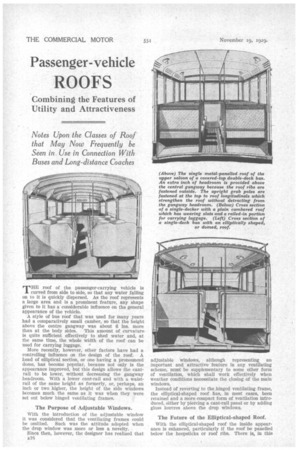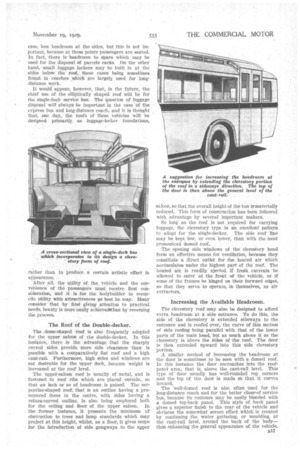Passenger-vehicle
Page 50

Page 51

If you've noticed an error in this article please click here to report it so we can fix it.
ROOFS
Combining the Features of Utility and Attractiveness
rr HE roof of the passenger-carrying vehicle is curved from side to side, so that any water falling on to it is quickly dispersed. As the roof represents a large area and is a prominent feature, any shape given to it has a considerable influence on the general appearance of the vehicle.
A style of bus roof that was used for many years had a comparatively small camber, so that the height above the centre gangway was about 6 ins, more than at the body sides. This amount of curvature is quite sufficient effectively to shed water and, at the same time, the whole width of the roof can be used for carrying luggage.
More recently, however, other factors have had a controlling influence on the design of the roof. A head of elliptical section, or one having a pronounced dome, has become popular, because not only is the appearance improved, but this design allows the cantrail to be lower, without decreasing the gangway headroom. With a lower cant-rail and with a waistrail of the same height as formerly, or, perhaps, an inch or two higher, the height of the side windows becomes much the same as it was when they were set out below hinged ventilating frames.
The Purpose of Adjustable Windows.
With the introduction of the adjustable window it was considered that the ventilating frames could be omitted. Such was the attitude adopted when the drop window was more or less a novelty.
Since then, however, the designer has realized that adjustable windows, although representing an important and attractive feature in any ventilating scheme, must be supplementary to some other form of ventilation, which shall work effectively when weather conditions necessitate the closing of the main windows.
Instead of reverting to the binged ventilating frame, the elliptical-shaped roof has, in most cases, been retained and a more compact form of ventilation introduced, either by piercing a cant-rail panel or by adding glass louvres above the drop windows.
The Future of the Elliptical-shaped Roof.
With the elliptical-shaped roof the inside appearance is enhanced, particularly if the roof be panelled below the hoopsticks or roof ribs. There is, in this case, less headroom at the sides, but this is not important, because at these paints passengers are seated. In fact, there is headroom to spare which may be used for the disposal of parcels racks. On the other hand, small luggage lockers may be built in at the sides belOw the roof, these cases being sometimea found, in coaeties which are largely used for longdistance work.
It would appear, however, that, in the future, the chief use of the elliptically shaped roof will be for the single-deck'service bus. The question of luggage disposal will always be Important :in the case of the €press hits and long-distance coacb, and it is thought that, one day, the roofs of these vehicles will be designed primarily, as luggage-locker foundations, rather than to produce a certain artistic effect in appearance.
After all, the utility of the vehicle and the convenience of the passengers must receive first consideration, and it , for the bodybuilder to reconcile utility with attractiveness as best he may Many consider that by first eying attention to practical needs, beauty is more easily achieved.than by reversing the process.
The Roof of the Double-decker.
The dome-shaped roof is also frequently adopted for the upper saloon of the double-decker. In this instance, there is the advantage that the sharply curved sides provide more side clearance than is possible with a comparatively fiat roof and a high cant-rail. Furthermore, high sides and windows are not desirable for the upper deck, because weight is increased at the roof level.
The upper-saloon roof is usually of metal, and is fastened to roof ribs which are placed outside, so that an inch or so of headroom is gained. The serpentine-shaped roof, that is an outline having a proflounced dome in the centre, with sides having a return-curved outline, is also being employed both for the ceiling and floor of the upper saloon. In the former instance, it presents the minimum of obstruction to trees and lamp standards which may project at this height, whilst, as a floor, it gives scope for the introduction of side gangways to the upper saloon, so that the overall height of the bus is-materially reduced. This form of 'construction has been followed with advantage by several important makers.
So long as the roof is not required for carrying luggage, the clerestory type is an excellent pattern to adopt for the single-decker. The side roof fine may be kept low, or even lower, than with the most pronounced domed roof.
The opening side windows of the clerestory head form an, effective means for ventilation, because they constitute a direct outlet for the heated air Which aecirmulates under the highest part of the roof. The heated air is readily ejected. if fresh currents be allowed to enter at the front of thevehicle, or if some of the frames be hinged on their forward edges, so that they serve to operate, in themselves, as air extractors, Increasing -the Available Headroom.
The clerestory roof may also be designed to afford extra headroom at a side entrance-. To do this, the ,side of the clerestory is extended sideways to the entrance and is. roofed over, the curve of this section of side roofing being parallel with that. of the lower parts of the main head, but as much above it as the clerestory is above the sides: of the roof. The door is then extended upward into. this side clerestory portion-.
A similar method of increasing the headroom at the door is sonietimes to be seen with, a domed roof. In this instance the door encroaches into the roofpanel area, that is, above the cant-rail level. This tnie of door usually has well-rounded top corners and the top of the door is made SO that it curves in ward.
The well-domed roof is also often used for the long-distance coach and. for the better class•of service bus, because its contours may be easily blended with a domed top-back panel. This style of back panel gives a superior finish to the rear of the vehicle and obviates the somewhat severe effect which is. created by continuing the water guttering, or moulding, at the cant-rail level, around the back of the body— thus enhancing the general appearance of the vehicle.




















































































































